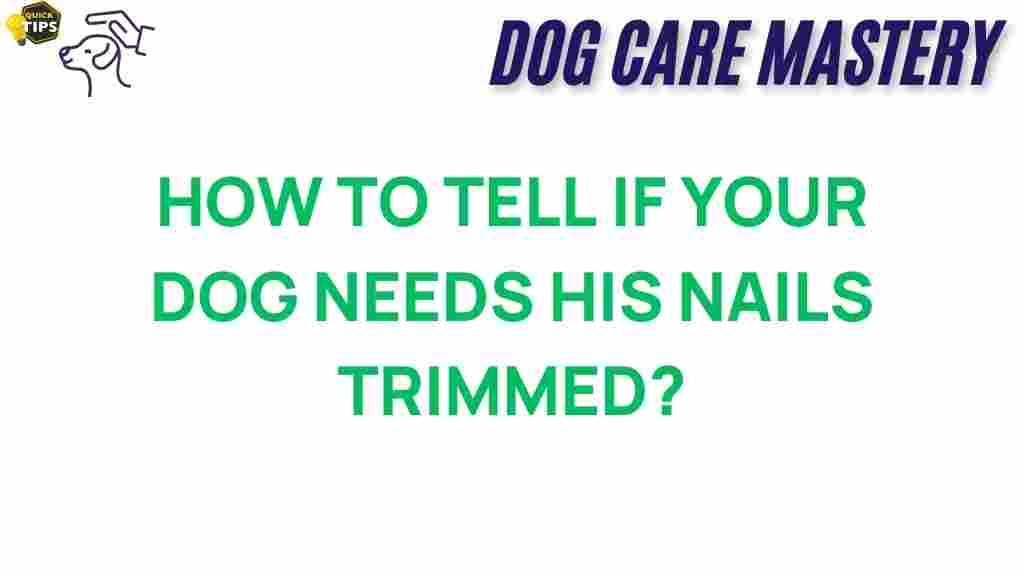Dog Nail Care: Is It Time for a Trim?
As a devoted pet owner, you want to ensure your furry friend is well cared for in every aspect, including their grooming. One often-overlooked element of grooming is dog nail care. Keeping your dog’s nails properly trimmed is crucial for their health and comfort. Long nails can lead to various problems, including pain, difficulty walking, and even injury. But how do you know when it’s time for a trim? In this article, we will explore the signs that indicate your dog’s nails need attention and provide you with essential tips for maintaining their nail health.
The Importance of Dog Nail Care
Maintaining your dog’s nails is not just about aesthetics; it plays a significant role in their overall health. Here are a few reasons why dog nail care is essential:
- Preventing Pain: Long nails can cause discomfort and pain, affecting your dog’s ability to walk or run.
- Avoiding Injuries: Overgrown nails are more likely to snag on surfaces, leading to breaks and injuries.
- Promoting Healthy Feet: Properly trimmed nails help maintain the natural structure of your dog’s paws.
- Enhancing Mobility: Dogs with properly trimmed nails are more agile and can move comfortably.
Signs Your Dog’s Nails Need Attention
To ensure your dog remains comfortable and mobile, keep an eye out for the following signs that their nails may need trimming:
- Clicking Sounds: If you can hear your dog’s nails clicking on the floor as they walk, it’s a clear sign that they are too long.
- Difficulty Walking: If your dog appears hesitant or is limping, long nails might be the culprit.
- Snagging on Carpets or Furniture: If your dog’s nails get caught on fabric or furniture, it’s time for a trim.
- Visible Curvature: Nails that curve or splay outwards indicate they have grown too long.
- Excessive Licking: If your dog frequently licks their paws, it could be due to discomfort from long nails.
Step-by-Step Process for Trimming Your Dog’s Nails
When you’ve determined that your dog’s nails need trimming, follow these steps to ensure a safe and effective nail care routine:
1. Gather Your Tools
Before you start, make sure you have the right tools at hand:
- Nail Clippers: Choose a type suited for your dog’s size (scissor-type for larger dogs, guillotine-type for smaller breeds).
- File or Grinder: A file or a nail grinder can help smooth out rough edges after cutting.
- Styptic Powder: This will help stop bleeding if you accidentally cut into the quick.
2. Get Your Dog Comfortable
Ensure your dog is relaxed and comfortable before starting. Here are some tips:
- Choose a quiet environment with minimal distractions.
- Have treats ready to reward your dog for good behavior.
- Consider having another person hold your dog if they tend to fidget.
3. Identify the Quick
The quick is the sensitive part of the nail that contains blood vessels and nerves. Avoid cutting into it, as it will cause pain and bleeding. Here’s how to locate it:
- For dogs with light-colored nails, the quick will appear as a pink area.
- For dogs with dark nails, trim only a little at a time until you see a darker center; that’s the quick.
4. Start Trimming
Begin trimming your dog’s nails carefully:
- Hold the paw firmly but gently.
- Trim only the tip of the nail, about 1/8 inch at a time.
- Take breaks as needed, especially if your dog seems anxious.
5. Smooth the Edges
After trimming, use a file or grinder to smooth out any sharp edges to prevent scratching and snagging.
6. Reward Your Dog
After the nail trimming session, reward your dog with treats and praise. This will help them associate nail trimming with positive experiences.
Troubleshooting Common Nail Trimming Issues
Even with the best intentions, you might face some challenges while trimming your dog’s nails. Here are some common issues and how to address them:
1. Fear or Anxiety
If your dog is fearful of nail clippers, try the following:
- Introduce the clippers gradually; let them sniff the tool without using it.
- Perform nail trimming in short sessions, focusing on one or two nails at a time.
2. Bleeding from the Quick
If you accidentally cut the quick, don’t panic. Here’s what to do:
- Apply styptic powder to the bleeding nail to help clot the blood.
- Keep your dog calm and prevent them from licking the area.
3. Reluctance to Allow Trimming
If your dog refuses to let you trim their nails, consider these tips:
- Use positive reinforcement; reward them for allowing you to touch their paws.
- Seek professional help from a groomer or veterinarian if necessary.
Conclusion: Prioritize Your Dog’s Nail Care
Regular dog nail care is essential for your pet’s health and comfort. By being aware of the signs that indicate your dog’s nails need trimming and following a straightforward process, you can keep your furry friend happy and pain-free. Remember to be patient, use the right tools, and always reward your dog for good behavior.
If you’re looking for more tips on dog grooming and care, check out this helpful resource. For professional grooming services, consider visiting your local groomer or veterinarian to ensure your dog receives the best care possible.
Don’t wait until it’s too late—keep your dog’s nails trimmed and healthy, and watch them thrive!
This article is in the category Grooming and created by dogcaremastery Team
